Solar nebula - Study guides, Class notes & Summaries
Looking for the best study guides, study notes and summaries about Solar nebula? On this page you'll find 204 study documents about Solar nebula.
Page 4 out of 204 results
Sort by
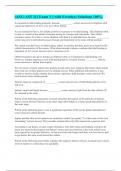
-
(ASU) AST 111 Exam 3 || with Errorless Solutions 100%.
- Exam (elaborations) • 9 pages • 2024
-
Available in package deal
-
- $11.29
- + learn more
Io experiences tidal heating primarily because __________. correct answers Io's elliptical orbit causes the tidal force on Io to vary as it orbits Jupiter. As you learned in Part A, Io's elliptical orbit is necessary to its tidal heating. This elliptical orbit, in turn, is a result of the orbital resonance among Io, Europa, and Ganymede. This orbital resonance causes Io to have a more elliptical orbit than it would otherwise, because __________. correct answers Io periodically passes Europa...

-
AST 111 Final Exam – Cumulative || All Correct.
- Exam (elaborations) • 13 pages • 2024
-
Available in package deal
-
- $11.49
- + learn more
7 protons and 8 neutrons correct answers N-15 (7 protons) is an isotope of nitrogen. Its nucleus consists of: absorb correct answers A Hydrogen atom with its electron in the second energy level can ________ energy so that the electron moves to an energy level farther from the nucleus. rising gas below the photosphere correct answers Granulation is caused by: Ozone (O3) correct answers As mentioned in class, the molecule that is most responsible for blocking gamma-rays from space is: ...

-
GSU ASTR 1020 Final Exam Questions and Answers 2024
- Exam (elaborations) • 11 pages • 2024
-
- $14.49
- + learn more
Luminosity - The total amount of power a star emits into space that's measured in watts. Apparent Brightness - Amount of starlight that actually reaches Earth HR Diagram - is a graphical tool that astronomers use to classify stars according to their luminosity, spectral type, color, temperature and evolutionary stage. Stars in the stable phase of hydrogen burning lie along the Main Sequence according to their mass. OBAFGKM - Oh Be A Fine Girl Kiss Me Main Sequence - the vast majorit...
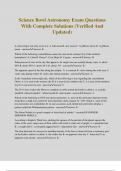
-
Science Bowl Astronomy Exam Questions With Complete Solutions (Verified And Updated)
- Exam (elaborations) • 11 pages • 2024
- Available in package deal
-
- $12.49
- + learn more
Science Bowl Astronomy Exam Questions With Complete Solutions (Verified And Updated) A solar eclipse can only occur at a: A. full moon B. new moon C. ½ gibbous moon D. ¼ gibbous moon - answerAnswer: B Which of the following constellations cannot be seen in the summer sky of the northern hemisphere? A. Libra B. Orion C. Ursa Major D. Cygnus - answerAnswer: B What percent of stars in the sky that appear to be single stars are actually binary stars: A. about 90% B. about 50% C. about 20 %...

-
astronomy 121|230 Quiz Questions Correctly Answered|27 Pages
- Exam (elaborations) • 27 pages • 2024
-
- $9.49
- + learn more
-- Life, orbital resonances, rings and gaps. - ️️Give three examples of current properties of the solar system that a model of its formation need not explain. Why? 11. How did the temperature structure of the solar nebula affect the planetary composition? - ️️-- The distance between a planet and the sun determines the temperatures at which each planet was created. For planets close to the Sun like Mercury and Venus, the temperature was too high for those planets to be formed with light ...
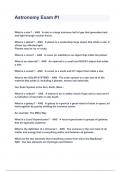
-
Astronomy Exam #1 Questions And Answers
- Exam (elaborations) • 13 pages • 2023
- Available in package deal
-
- $13.49
- + learn more
Astronomy Exam #1 Questions And Answers What is a star? - ANS A star is a large luminous ball of gas that generates heat and light through nuclear fusion. What is a planet? - ANS A planet is a moderately large object that orbits a star. It shines by reflected light. Planets may be icy or rocky What is a moon? - ANS A moon (or satellite) is an object that orbits the planet. What is an asteroid? - ANS An asteroid is a small and ROCKY object that orbits a star. What i...
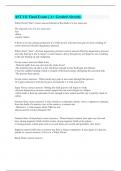
-
AST 111 Final Exam || A+ Graded Already.
- Exam (elaborations) • 9 pages • 2024
-
Available in package deal
-
- $10.79
- + learn more
White Dwarf "Star" correct answers Result of the death of a low mass star The exposed core of a low mass star; -hot -dense -mostly carbon If there is no new energy production in a white dwarf, what prevents gravity from crushing it? correct answers Electron degeneracy pressure White dwarf "stars"- electron degeneracy pressure correct answers Electron degeneracy pressure will only hold up a star to about 1.4 solar masses, above that gravity will begin to win, resulting in the st...

-
Earth Science CDM Review Questions and Answers Already Passed
- Exam (elaborations) • 46 pages • 2023
-
Available in package deal
-
- $10.49
- + learn more
Earth Science CDM Review Questions and Answers Already Passed Physical Geology Examination of the materials that make up Earth and the possible explanations for the many processes that shape our planet Historical Geology To understand Earth's long history Oceanography Study of the composition of seawater, as well as coastal processes, seafloor topography, and marine life Meterology The study of the atmosphere and the processes that produce weather and climate Astronomy The study of the univ...

-
SDSU Oceanography 100 Final Exam Questions and Answers Already Passed
- Exam (elaborations) • 18 pages • 2024
- Available in package deal
-
- $9.99
- + learn more
SDSU Oceanography 100 Final Exam Questions and Answers Already Passed What is the origin of the Earth? Formed out of a solar nebula What are the origins of Life? Archaea - the oldest origin of life on Earth What is kinetic energy? The energy of motion What is heat energy? Energy created by particles of matter rubbing together What is density? A measurement of the amount of matter in a given volume of something. (mass per unit volume) What is convection? Transfer of heat throu...
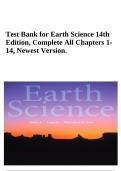
-
Test Bank for Earth Science 14th Edition By Edward J. Tarbuck, Complete All Chapters 1- 14, Newest Version.
- Exam (elaborations) • 637 pages • 2024
-
- $34.49
- + learn more
Test Bank for Earth Science 14th Edition By Edward J. Tarbuck, Complete All Chapters 1- 14, Newest Version. Chapter 1 Introduction to Earth Science 1) What are the basic differences between the disciplines of physical and historical geology? A) Physical geology is the study of fossils and sequences of rock strata; historical geology is the study of how rocks and minerals were used in the past. B) Historical geology involves the study of rock strata, fossils, and geologic events, utilizing ...

$6.50 for your textbook summary multiplied by 100 fellow students... Do the math: that's a lot of money! Don't be a thief of your own wallet and start uploading yours now. Discover all about earning on Stuvia


